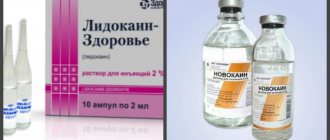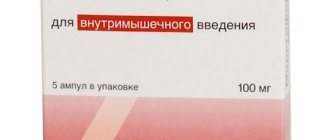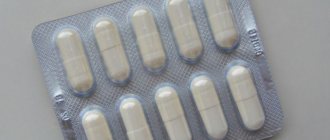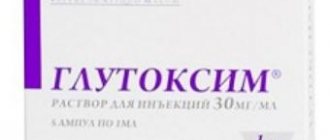Compound
Clindamycin capsules contain the active component clindamycin (hydrochloride form), as well as additional ingredients: talc, lactose monohydrate, corn starch, magnesium stearate.
The solution contains the active ingredient clindamycin (phosphate form), as well as auxiliary ingredients: benzyl alcohol, disodium edetate, water.
Clindamycin cream contains the active ingredient clindamycin (phosphate form), as well as auxiliary ingredients: macrogol 1500 , castor oil, sodium benzoate, propylene glycol, emulsifier No. 1.
Release form
The product is produced in the form of capsules, solution and vaginal cream.
Gelatin capsules have a purple body and a red cap. Inside there is a powder that may be white or white-yellow in color. Capsules are packed in blisters of 8 pieces, in a cardboard pack of 2 such blisters.
The solution, which is administered intravenously or intramuscularly, is clear and may be colorless or slightly yellowish. Contained in ampoules of 2 ml. There are 5 ampoules in blister packs, 2 packs in a cardboard box.
Vaginal ointment 2% can have white, yellowish-white, creamy shades. It has a weak specific aroma. Contained in aluminum tubes of 20 g or 40 g, the kit includes an applicator.
pharmachologic effect
The substance clindamycin belongs to the group of lincosamide antibiotics. It has a wide range of effects and is a bacteriostatic.
In the body it binds to the 50S subunit of the ribosome and inhibits protein synthesis in microorganisms. Shows activity against Staphylococcus spp., Streptococcus spp. (the exception is Enterococcus spp.), Streptococcus pneumoniae, anaerobic and microaerophilic gram-positive cocci, Clostridium tetani, Clostridium perfringens, Corynebacterium diphtheriae, Mycoplasma spp., Bacteroides spp. (including Bacteroides melaningenicus and Bacteroides fragilis). Also demonstrates activity against anaerobic gram-positive, non-spore forming bacilli.
Most strains of Clostridium perfringens are also sensitive to this substance, but other varieties of clostridia (in particular Clostridium tertium, Clostridium sporogenes) demonstrate resistance to this drug. In this regard, for diseases caused by Clostridium spp., it is recommended to conduct an antibiogram before starting treatment.
The mechanism of action of this drug and its antimicrobial spectrum is close to lincomycin.
The phosphate form of clindamycin is inactive in vitro, but it is rapidly hydrolyzed in vivo to form clindamycin, which exhibits antibacterial activity.
Pharmacological properties of the drug Clindamycin
Semi-synthetic antibiotic of the lincosamide group. Suppresses protein synthesis in microbial cells by interacting with 50S ribosomal subunits. It has a bacteriostatic effect, and in higher concentrations it is bactericidal against some microorganisms. Active against the following microorganisms:
- aerobic gram-positive cocci, including Staphylococcus aureus, Staphylococcus epidermidis (including strains that produce and do not produce penicillinase); Staphylococcus spp. (except Streptococcus faecalis ), Streptococcus pneumoniae ;
- anaerobic gram-negative bacteria, including Bacteroides spp. (including B. fragilis , B. melaninogenicus ), Fusobacterium spp .;
- anaerobic gram-positive non-spore-forming bacteria, including Propionibacterium , Eubacterium , Actinomyces ;
- anaerobic and microaerophilic gram-positive cocci, including Peptococcus spp. , Peptostreptococcus spp .
Chlamydia trachomatis is sensitive to clindamycin . Most strains of Clostridium perfringens, Cl. sporogenes and Cl. tertium are often resistant to clindamycin. After intramuscular administration of 600 mg of clindamycin phosphate, the maximum serum concentration (9 mcg/ml) is achieved 1–3 hours after injection. After intravenous administration of 300 mg over 10 minutes or 600 mg over 20 minutes, the maximum concentration of clindamycin, 7 and 10 mcg/ml, respectively, is reached at the end of the administration. Equilibrium concentration is achieved after the third administration. After oral administration, rapid and almost complete (about 90%) absorption of clindamycin occurs. In adults, after oral administration of clindamycin at a dose of 150 mg, its maximum concentration in the blood plasma (2.5 μg/ml) is achieved after 45 minutes, after 3 hours the plasma concentration is 1.5 μg/ml, and after 6 hours - 0. 7 µg/ml. When clindamycin palmitate is administered orally to children in doses of 2, 3 and 4 mg/kg every 6 hours, its maximum concentration in the blood plasma is reached 60 minutes after the first dose and is 1.2, 2.2 and 2.4 μg/ml, respectively. Equilibrium concentration in blood plasma is achieved after the 5th dose. Plasma protein binding is 40–90%. Does not accumulate in the body. Clindamycin easily penetrates into most tissues and body fluids. Its concentration in bone tissue is on average 40% of the concentration in blood plasma, in synovial fluid - 50%, in sputum - 30–75%, in peritoneal fluid - 50%, in pleural fluid - 50%, in pus - 30%, in breast milk - 50–100%, in fetal blood - 40%. Clindamycin does not penetrate into the CSF. Almost completely metabolized in the liver (70–80%). The half-life of clindamycin is 1.5–3.5 hours. It is excreted primarily in the feces in the form of inactive metabolites; 10–20% of clindamycin is excreted in the urine. After a single intravaginal administration of 100 mg of clindamycin cream, approximately 4% of the administered dose enters the systemic circulation. The maximum concentration of the antibiotic in blood plasma is on average 20 ng/ml. Clindamycin is active against microorganisms that cause bacterial vaginosis: Gardnerella vaginalis , Mobiluncus spp. , Bacteroides spp. , Mycoplasma hominis , Peptostreptococcus spp. Not active against Trichomonas vaginalis and Candida albicans . When applied externally in the form of clindamycin phosphate, it quickly hydrolyzes to form clindamycin. After repeated use of clindamycin phosphate in the form of a 1% gel, the degree of resorption into the systemic circulation is 1.6 and 2.5% of the morning and evening doses, respectively. The content of clindamycin in urine is 0.053 and 0.07% of the morning and evening doses, respectively. Clindamycin quickly accumulates in the comedones of acne patients. The average concentration of the antibiotic in the contents of comedones after applying clindamycin in gel form significantly exceeds the MIC for all strains of Propionibacterium acnes , the causative agent of acne (0.4 μg/ml). Reduces the amount of free fatty acids on the surface of the skin (from 14 to 2%), which also helps clear it from acne.
Pharmacokinetics and pharmacodynamics
Clindamycin is completely and quickly absorbed from the gastrointestinal tract; with simultaneous ingestion of food, absorption slows down, while the concentration of the substance in the plasma remains unchanged. Penetrates into the tissues and fluids of the body, passes through the blood-brain barrier poorly, but in the case of inflammation of the meninges, permeability increases.
The maximum concentration in the blood is observed after oral administration after 0.75-1 hour, if intramuscular administration is carried out, after 1 hour in adult patients and after 3 hours in children. When administered intravenously, the highest concentration is observed at the end of the infusion.
Therapeutic concentrations in the blood are observed for 8-12 hours. The half-life is 2.4 hours. Metabolism occurs in the liver, producing active and inactive metabolites . Excretion takes place over 4 days through the kidneys and intestines.
When the drug is administered intravaginally, about 3% of the administered dose is systemically absorbed.
Buy Clindamycin solution for injection intravenously intramuscularly 15% 2ml No. 10 in pharmacies
Clindamycin Buy Clindamycin in pharmacies Clindamycin in the drug directory DOSAGE FORMS injection solution 150mg/ml injection solution 300mg/2ml
MANUFACTURERS Hemofarm concern A.D. (Yugoslavia)
GROUP Antibiotics of the lincomycin group
COMPOSITION Active ingredient: clindamycin.
INTERNATIONAL NON-PROPENTED NAME Clindamycin
SYNONYMS Dalatsin, Dalatsin C, Dalatsin C phosphate, Zerkalin, Klindafer, Klindacin, Klindovit
PHARMACOLOGICAL ACTION Antibacterial. Binds to the 50S subunit of the ribosomal membrane and inhibits protein synthesis in microorganisms. It is quickly and completely absorbed into the gastrointestinal tract; simultaneous food intake slows down absorption without changing the completeness. Easily penetrates biological fluids and tissues; passes through the blood-brain barrier (BBB) poorly. After intramuscular administration, the maximum concentration in the blood is reached after 2-2.5 hours, in a therapeutic concentration it circulates in the blood for 8-12 hours, the half-life is 2.4 hours; metabolized in the liver, most of the active and inactive metabolites are excreted within 4 days in the urine, a smaller part is excreted through the intestines. Refers to reserve antibiotics that suppress gram-positive cocci (staphylococci, streptococci, pneumococci), incl. producing penicillinase, as well as mycoplasmas, bacteroides, fusobacteria, actinomycetes, some strains of Haemophilus influenzae, causative agents of anthrax, gas gangrene and tetanus. According to the mechanism of action and antimicrobial spectrum, it is close to lincomycin.
INDICATIONS FOR USE Infections of the upper and lower respiratory tract (pharyngitis, tonsillitis, scarlet fever, diphtheria, sinusitis, otitis, pneumonia, including aspiration, lung abscess, bronchitis), abdominal cavity (peritonitis, abscess), oral cavity, urogenital area (chlamydia, endometritis, vaginal infections, tubo-ovarian inflammation), skin and soft tissues (infected wounds, abscesses), acute and chronic osteomyelitis, septicemia, bacterial endocarditis, acne (externally).
CONTRAINDICATIONS Hypersensitivity, myasthenia gravis, lactation. Restrictions on use: Severe liver and kidney dysfunction, infancy (up to 1 month), pregnancy.
SIDE EFFECTS Dyspepsia (abdominal pain, nausea, vomiting, diarrhea), esophagitis, liver dysfunction, jaundice, dysbacteriosis (clostridial pseudomembranous colitis), allergic reactions (urticaria, erythema), leukopenia, neutropenia, eosinophilia, thrombocytopenia, hyperbilirubinemia. At the injection site there is irritation, pain, infiltrates and abscesses, thrombophlebitis. With rapid intravenous administration - cardiovascular failure (collapse, cardiac arrest), arterial hypotension.
INTERACTIONS Incompatible with erythromycin, ampicillin, diphenylhydantoin, barbiturates, aminophylline, calcium gluconate and magnesium sulfate. Strengthens (mutually) the effect of rifampicin, aminoglycosides - streptomycin, gentamicin. Deepens muscle relaxation caused by n-cholinergic blockers. Co-administration with antidiarrheal drugs increases the risk of developing pseudomembranous colitis. Concomitant use with solutions containing B complex vitamins is not recommended.
METHOD OF APPLICATION AND DOSAGE IM or IV drip (at a rate of no more than 30 mg/min) 300 mg 2 times a day, for severe infections - up to 1.2-4.8 g/day (2-4 administrations) , children - 10-40 mg/kg/day (3-4 administrations).
OVERDOSE No data available.
SPECIAL INSTRUCTIONS No data available.
STORAGE CONDITIONS At a temperature of 20-25 °C.
Indications for use
Clindamycin solution and tablets are used for the following diseases and conditions:
- diseases of an infectious-inflammatory nature that were provoked by the action of microorganisms sensitive to clindamycin ;
- infections of the ENT organs, as well as infectious diseases of the upper respiratory tract and lower respiratory tract;
- diphtheria , scarlet fever ;
- urogenital infections;
- infections of the oral cavity, abdominal cavity;
- infections of soft tissues and skin;
- septicemia (primarily anaerobic);
- acute and chronic osteomyelitis
- endocarditis ;
- taken for the prevention of intra-abdominal abscesses and peritonitis after intestinal perforation or after traumatic infection (combined with aminoglycosides).
Clindamycin cream and gel is used for bacterial vaginosis.
Indications for the use of suppositories with clindamycin:
- bacterial vaginosis , provoked by microorganisms sensitive to the substance.
Use of the drug Clindamycin
Systemic use: the dose depends on the severity of the disease, the condition of the patient and the sensitivity of the infectious agent to the antibiotic. Adults with infectious diseases of the abdominal cavity, complicated or severe infections are usually prescribed 2400–2700 mg of clindamycin phosphate per day in 2–4 administrations. There is experience with the successful use of clindamycin at a dose of 4800 mg/day. In milder forms of infection and in the presence of a pathogen more sensitive to the antibiotic, the therapeutic effect is achieved by prescribing clindamycin in lower doses - 1200–1800 mg/day in 3–4 administrations. It is not recommended to administer more than 600 mg IM at a time. Children over 1 month of age are prescribed 20–40 mg/kg per day parenterally only in cases of urgent need. For adnexitis/pelvioperitonitis, a dose of 900 mg is administered intravenously at an interval of 8 hours (with simultaneous administration of antibiotics active against gram-negative pathogens). IV administration of these drugs is carried out for at least 4 days and then within 48 hours after the patient’s condition improves. After achieving a clinical effect, treatment can be continued with oral forms of clindamycin - 450 mg with an interval of 6 hours until the completion of a 10-14-day course of therapy. Orally prescribed for infectious and inflammatory diseases of mild to moderate severity. Adults are prescribed 150–450 mg every 6 hours. The duration of treatment is determined individually, but for infections caused by β-hemolytic streptococcus, therapy should be continued for at least 10 days. For the treatment of cervical infections caused by Chlamydia trachomatis , 450 mg of clindamycin hydrochloride is prescribed orally 4 times a day for 10–14 days. For children over 1 month of age, the daily dose should be 8–25 mg/kg in 3–4 doses. In children weighing 10 kg or less, the minimum recommended dose should be 37.5 mg of clindamycin palmitate 3 times a day. External use: a thin layer of 1% gel is applied to clean and dry skin at the affected area 2 times a day - morning and evening. Intravaginal use: 5 g of 2% cream is inserted into the vagina using an applicator before bedtime. The course of treatment is 3 days.
Contraindications
The use of this remedy is contraindicated:
- for bronchial asthma ;
- with myasthenia gravis ;
- for ulcerative colitis ;
- for rare hereditary diseases (lactase deficiency, galactose intolerance, glucose-galactose malabsorption);
- during pregnancy and breastfeeding ;
- for a child under 3 years of age, intravenous and intramuscular administration is contraindicated; for children under 8 years of age, taking capsules is contraindicated;
- high sensitivity to the components of the drug.
Prescribe with caution to people who suffer from severe renal or liver failure, and to elderly patients.
Side effects
When taking the medicine, patients may experience some side effects:
- digestive system: dyspepsia, jaundice, esophagitis, pseudomembranous enterocolitis, hyperbilirubinemia, dysbacteriosis , liver dysfunction;
- musculoskeletal system: in rare cases, disturbances in neuromuscular conduction may occur;
- hematopoiesis: leukopenia, neutropenia, agranulocytosis, thrombocytopenia;
- allergy manifestations: rash, skin itching , urticaria , sometimes dermatitis, anaphylactoid manifestations, eosinophilia;
- heart and blood vessels: when the solution is administered intravenously and quickly - a decrease in blood pressure , weakness, dizziness ;
- local manifestations: pain and thrombophlebitis (at the injection site), irritation;
- other side effects: superinfection.
When using Clindamycin cream, the following side effects may develop:
- urination: irritation of the vaginal and vulvar mucosa, candidiasis , vulvovaginitis, trichomonas vaginitis, vaginal infections, menstrual cycle disorders, uterine bleeding, vaginal pain, dysuria, the appearance of discharge, endometriosis , glucosuria, proteinuria ;
- general manifestations: pain and cramps in the abdomen , bloating, fungal and bacterial infections, headache , bad breath, swelling , pain in the lower abdomen, upper respiratory tract infections, back pain, allergic manifestations ;
- gastrointestinal system: nausea, diarrhea , constipation , vomiting, flatulence , dyspepsia, gastrointestinal disorders;
- skin: skin itching, erythema, rash, candidiasis , urticaria ;
- endocrine system: hyperthyroidism ;
- CNS: dizziness ;
- respiratory system: nosebleeds.
Side effects of the drug Clindamycin
From the digestive tract - possible abdominal pain, nausea, vomiting, diarrhea, esophagitis, jaundice, increased activity of liver transaminases; Cases of the development of pseudomembranous colitis have been described. Allergic reactions - maculopapular rash, urticaria, itching, in rare cases - bullous rash, exfoliative dermatitis, morbilliform rash, eosinophilia, anaphylactoid reactions. On the part of the hematopoietic system , cases of neutropenia, agranulocytosis and thrombocytopenia have been described, but a reliable causal relationship between these changes and the use of clindamycin has not been found. From the cardiovascular and respiratory systems - with too rapid intravenous administration of clindamycin, rare cases of respiratory and cardiac arrest, as well as the development of arterial hypotension, have been observed. From the reproductive system - cervicitis, vaginitis, vulvar irritation. Local reactions - with intramuscular administration of clindamycin solution, local irritation, soreness and formation of abscesses in the area of administration may occur; with intravenous administration - thrombophlebitis.
Instructions for use of Clindamycin (Method and dosage)
Clindamycin is administered intravenously and intramuscularly at a dose of 300 mg twice daily for adult patients. If treatment of a severe infection is necessary, 1.2-2.7 g of medication per day is indicated, this dose should be divided into 3-4 administrations.
You cannot prescribe intramuscularly a single dose of medication that exceeds 600 mg. The highest permissible dose for intravenous administration is 1.2 g over 1 hour.
Children who are three years old should receive a dose of 15-25 mg per 1 kg per day, which must be divided into 3-4 times in equal doses.
In case of severe infection, you can increase the dose to 25-40 mg per 1 kg of weight, this dose should be divided into 3-4 equal doses.
There is no need to adjust the dose in patients with severe renal or hepatic impairment, provided that the drug is prescribed at intervals of at least 8 hours.
Before intravenous administration, the drug must be diluted to a concentration of no more than 6 mg/ml, the resulting solution is administered dropwise, the administration period is from 10 to 60 minutes, depending on the dose. Injection is not recommended. The solvent can be a solution of 0.9% sodium chloride and a solution of 5% dextrose.
Clindamycin tablets, instructions for use
The tablets must be taken orally; adult patients and adolescents over 15 years of age with moderate illnesses receive 1 caps. 4 times a day. If there is a severe infectious disease, the dose can be increased by 2-3 capsules. Children aged 8 to 12 years are prescribed 1 caps. 4 times a day. Do not exceed the dose of 4 capsules. per day.
Adolescents from 12 to 15 years old are prescribed 1-2 caps. 3 times a day. Do not exceed the dose of 6 capsules. per day.
The instructions for the cream provide for intravaginal use. It is best to use the product before bedtime for 3-7 days.
Suppositories with clindamycin are used intravaginally, 1 pc. 1 per day.
Use candles before bed, course – 3-7 days. Before use, you need to remove the protective film, insert it deep into the vagina, and do this in a lying position.
Clindamycin
Clindamycin is an antibiotic from the lincosamide group that acts on many representatives of pathogenic and opportunistic microflora of the human body, not only on bacteria (antibacterial component), but also on protozoa (antiprotozoal action). By binding to the 50S ribosomal subunit of microbial cells, clindamycin suppresses the synthesis of protein structures in microorganisms that are vulnerable to it. As a result, the growth and development of unwanted guests, whose images are so colorfully described in microbiology textbooks, are inhibited, i.e. a bacteriostatic effect is observed, which, with an increase in the concentration of the antibiotic in the blood, can successfully transform into a bactericidal one. As you can see, the mechanism of action of clindamycin and the species composition of its “regular clients” (read: spectrum of antibacterial action) are very close to that of lincomycin, however, against some pathogenic strains the former acts much more actively (2-10 times).
Clindamycin’s “sniper notebook” includes infectious agents that are sensitive to it, such as aerobic gram-positive bacilli Staphylococcus spp. (including aureus and epidermidis species that produce penicillinase and are therefore resistant to penicillins), Pneumococcus spp., anaerobic gram-negative bacteria Bacteroides spp. (including fragilis and melaninogenicus species), Fusobacterium spp., gram-positive non-spore-forming anaerobes such as Propionibacterium spp., Actinomyces spp., Eubacterium spp., microaerophilic gram-positive cocci Peptostreptococcus spp.
, Peptococcus spp., Clostridia spp. (the latter most often develop resistance to clindamycin, so a sensitivity test is performed before starting treatment).
Separate mention should be made of clindamycin as a treatment for bacterial vaginosis: it is active against Mobiluncus spp., Gardnerella vaginalis, Bacteroides spp., Mycoplasma hominis, Peptostreptococcus spp. As for microorganisms such as Chlamydia trachomatis, Trichomonas vaginalis, Candida albicans Neisseria gonorrhoeae and the Herpes simplex virus, which also often cause vaginal infections, clindamycin will not be as effective.
Clindamycin is available in three dosage forms: solution for intravenous and intramuscular administration, capsules and vaginal cream. When administered by injection, the recommended dose of the drug is 300 mg twice a day. The maximum single dose depends on the route of administration: 1.2 g for intravenous and 600 mg for intramuscular injection. For children over 1 month. The daily dose is calculated depending on body weight: 10–40 mg per 1 kg. Clindamycin is taken orally every 6-8 hours, 150 mg, and in severe cases - 300-450 mg. The daily dose for children is 8-25 mg per 1 kg for 3-4 doses. The intravaginal form is used once a day, usually before bedtime, when one five-gram applicator is inserted into the vagina.
Interaction
There is an increase in the effect of the aminoglycosides Streptomycin, Gentamicin , Rifampicin when taken simultaneously with Clindamycin.
Activates the effect of competitive muscle relaxants, as well as muscle relaxation caused by n-cholinergic blockers.
Not compatible with barbiturates, Ampicillin , Calcium gluconate , magnesium sulfate, Aminophylline.
Antagonism with Chloramphenicol and Erythromycin .
It is not recommended to take simultaneously with solutions that contain B vitamins
Clindamycin and drugs with antidiarrheal effects should not be prescribed simultaneously, as the likelihood of developing pseudomembranous colitis increases.
When used simultaneously with opioid analgesics , the effect of respiratory depression may increase, up to the development of apnea .
Cross-resistance has been observed between Lincomycin and Clindamycin. Antagonism between Erythromycin and Clindamycin also appears.
It is not recommended to use with other drugs for intravaginal administration.
Drug interactions Clindamycin
When used simultaneously with aminoglycosides, the spectrum of antimicrobial action expands. Clindamycin and erythromycin are antagonists, and therefore the simultaneous administration of these drugs is not recommended. Clindamycin has the ability to block neuromuscular transmission and may enhance the effect of muscle relaxants. Clindamycin solution is compatible with the following antibiotics (prescribed in moderate therapeutic doses): amikacin, aztreonam, cefamandole, cefazolin, cefotaxime, cefoxitin, ceftazidine, ceftizoxime, gentamicin, netilmicin, piperacillin and tobramycin. Clindamycin phosphate is not compatible with ampicillin, phenytoin, barbiturates, aminophylline, calcium gluconate or magnesium sulfate.
List of pharmacies where you can buy Clindamycin:
- Moscow
- Saint Petersburg
special instructions
Pseudomembranous colitis may occur both while taking the medication and 2-3 weeks after completion of therapy. With this condition, a person experiences diarrhea , fever , leukocytosis , and abdominal pain.
If such symptoms develop, you need to stop the drug and take ion exchange resins. In severe cases of colitis, it is necessary to replace lost fluid, protein and electrolytes, and prescribe oral Vancomycin or Metronidazole.
During treatment, you should not take medications that inhibit intestinal motility.
If long-term use of the drug by children is practiced, it is necessary to periodically monitor blood and liver condition. When taking large doses of the drug, it is necessary to monitor clindamycin in the blood plasma .
People diagnosed with severe liver failure should have their liver function monitored.
Before starting to take the drug intravaginally, it is necessary to exclude in laboratory Chlamydia trachomatis, Trichomonas vaginalis, Neisseria gonorrhoeae, Candida albicans, Herpes simplex, which very often provoke the development of vulvovaginitis.
When clindamycin is used intravaginally, increased development of insensitive microorganisms, in particular yeast-like fungi, may occur.
Since there is a possibility of insignificant systemic absorption of the drug, diarrhea may develop during the use of suppositories or cream. In this case, the drug is canceled.
It should be noted that during the treatment period you should abstain from sexual activity and not use other drugs for intravaginal use.
This medicine contains components that can make products made of rubber and latex less durable. Therefore, the use of condoms, diaphragms, and other latex contraceptives is not recommended.
Does not affect the ability to drive a car or engage in other activities that require concentration.
Clindamycin (solution)
To avoid complications, use strictly as prescribed by your doctor!
There have been case reports of severe hypersensitivity reactions, including severe skin reactions such as drug rash with eosinophilia and systemic symptoms (DRESS syndrome), Stevens-Johnson syndrome, toxic epidermal necrolysis and acute generalized exanthematous pustulosis in patients receiving clindamycin therapy. If a hypersensitivity reaction or severe skin reaction occurs, treatment with clindamycin should be discontinued and appropriate therapy for these complications should be initiated (see sections "Contraindications" and "Side Effects").
The drug contains benzyl alcohol. There are reports that benzyl alcohol causes Gasping Syndrome
- disorders of the respiratory system, manifested in the form of suffocation) with a fatal outcome in children.
Although therapeutic doses of the drug usually contain a dose of benzyl alcohol significantly lower than the dose at which the development of this complication was observed, the minimum amount of benzyl alcohol that has a toxic effect is unknown. The degree of toxicity of benzyl alcohol depends on the amount of drug administered and the ability of the liver and kidneys to detoxify chemical compounds. Premature and low birth weight infants are at higher risk of toxicity. The amount of benzyl
alcohol per 1 ml of drug solution is 9 mg.
Clostridium difficile
associated diarrhea is observed with the use of almost all antibacterial drugs, including clindamycin, and manifests itself from mild forms of diarrhea to severe colitis with a fatal outcome. Antibacterial drugs suppress the normal intestinal flora, which can contribute to increased proliferation of clostridia. Clostridium difficile produces toxins A and B, leading to the development of Clostridium difficile associated diarrhea. Hypertoxin-producing strains of Clostridium difficile lead to increased morbidity and mortality because they may be resistant to antibiotic therapy and may require colonectomy for treatment. All cases of diarrhea in patients during antibiotic therapy should be considered suspicious for the development of Clostridium difficile associated diarrhea. A thorough medical history is required if Clostridium difficile associated diarrhea develops within 2 months after the prescription of antibacterial drugs. Pseudomembranous colitis is manifested by diarrhea, leukocytosis, fever, abdominal pain (sometimes accompanied by the discharge of blood and mucus in the stool) and can develop both while taking clindamycin and 2-3 weeks after stopping treatment. After a diagnosis of pseudomembranous colitis is made, in mild cases it is sufficient to discontinue treatment and use ion exchange resins (colestyramine, colestipol); in moderate and severe cases, replacement of the loss of fluid, electrolytes and protein, and the prescription of an antibacterial drug effective against Clostridium difficile are indicated, for example, vancomycin at a dose of 125-500 mg, or bacitracin at a dose of 25,000 units orally 4 times a day for 7-10 days, or metronidazole at a dose of 250-500 mg 3 times a day.
Drugs that reduce gastrointestinal motility should not be coadministered with clindamycin.
Clindamycin should be used with caution in patients with a history of gastrointestinal diseases, especially colitis. Antibiotic-associated colitis and diarrhea occur more frequently and more severely in debilitated and/or elderly patients.
When using all antibacterial agents, including clindamycin, excessive growth of microorganisms that are insensitive to this drug, especially yeast-like fungi, is possible. If superinfection develops, appropriate measures should be taken depending on the clinical situation.
Clindamycin should not be used to treat meningitis because it does not penetrate the blood-brain barrier well.
When using the drug in high doses, monitoring the concentration of clindamycin in the blood plasma is necessary. If treatment is carried out over a long period of time, liver and kidney function tests should be carried out regularly.
In patients with impaired liver and kidney function, no dose adjustment of the drug is required, since clindamycin practically does not accumulate in the body if the drug is administered at intervals of 8 hours. Patients with severe hepatic and/or renal insufficiency should use the drug with caution and monitor liver function (“ liver" enzymes) and kidneys.
The drug should not be administered intravenously undiluted or simultaneously.
The infusion must be carried out for at least 10-60 minutes (see section “Method of administration and dosage”).
Clindamycin analogs
Level 4 ATC code matches:
Lincomycin Hydrochloride
Lincomycin
Structural analogues of the active ingredient are the drugs Dalatsin , Zerkalin , Clindamycin phosphate , Clindatop , Klimitsin , Klindafer , Klindes , Clindacin , Klindovit . A specialist should prescribe the optimal remedy.
During pregnancy and lactation
Clindamycin in solution and capsules is not prescribed during pregnancy and lactation .
The product can be used intravaginally for women in the second and third trimesters of pregnancy. In the first months of pregnancy, it is prescribed only if the expected benefit outweighs the potential harm when using cream or suppositories. During lactation, you need to carefully weigh the expected benefits and potential harm. The product can only be used under the supervision of a physician.
Reviews of Clindamycin
There are different reviews about the drug online. There are opinions that the medicine effectively cures a number of diseases. However, there are also opinions that the medicine in the form of capsules, as well as suppositories with clindamycin, turned out to be ineffective.
Side effects are rarely written about. Women mention that when using the product intravaginally, burning and discomfort were noted. Some patients use acne cream and write that its regular use allows them to almost completely get rid of acne.
Drug interactions
Clindamycin mutually enhances the effect of rifampicin and the aminoglycosides gentamicin and streptomycin (especially in the prevention of peritonitis after intestinal perforation and treatment of osteomyelitis).
The drug enhances muscle relaxation, which is caused by n-cholinergic blockers, as well as the effect of competitive muscle relaxants.
Clindamycin is incompatible with barbiturates, ampicillin, aminophylline, magnesium sulfate and calcium gluconate; exhibits antagonism with chloramphenicol and erythromycin.
Co-administration with phenytoin, aminoglycosides and solutions that contain B complex vitamins is not recommended.
When used simultaneously with antidiarrheals, the risk of developing pseudomembranous colitis increases.
When Clindamycin is used together with opioid (narcotic) analgesics, the effects they cause may be enhanced (in particular, respiratory depression up to apnea).
No drug interactions were observed in studies of Clindamycin cream. There is no information on the combined use of vaginal cream and other drugs.
Clindamycin price, where to buy
The price of Clindamycin tablets is on average 160 rubles for 16 pieces. 300 mg tablets are produced under other names. You can buy the product in ampoules for a price starting from 580 rubles. Gel and ointment can be bought at any pharmacy. The price of Clindamycin cream is on average 350 rubles. The price of suppositories with Clindamycin is 550-600 rubles for 3 pcs.
- Online pharmacies in RussiaRussia
- Online pharmacies in UkraineUkraine
- Online pharmacies in KazakhstanKazakhstan
LuxPharma* special offer
- Deriva S (Adapalene, Clindamycin) gel 15 g
1950 rub. order
ZdravCity
- Clindamycin-VERTEX vaginal cream 2% tube 20gVertex AO
455 rub. order
Pharmacy Dialogue
- Clindamycin (caps. 150 mg No. 16)Hemofarm
RUB 153 order
show more
Pharmacy24
- Clindamycin-M 0.15 g N10 capsules PAT Monpharm, Ukraine
49 UAH.order
PaniPharmacy
- Clindamycin capsule Clindamycin-M capsules 0.15g No. 10 Ukraine, Monfarm JSC
64 UAH order
show more







